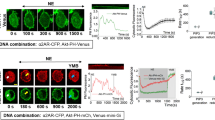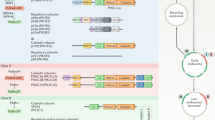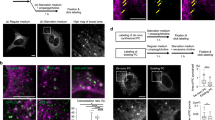Abstract
Diacylglycerol kinases (DGKs) terminate signalling from diacylglycerol by converting it to phosphatidic acid1,2,3,4,5,6,7,8. Diacylglycerol regulates cell growth and differentiation, and its transient accumulation in the nucleus may be particularly important in this regulation9,10. Here we show that a fraction of DGK-ζ is found inthe nucleus, where it regulates the amount of nuclear diacylglycerol. Reducing nuclear diacylglycerol levels by conditional expression of DGK-ζ attenuates cell growth. The nuclear-localization signal of DGK-ζ is located in a region that is homologous to the phosphorylation-site domain of the MARCKS protein. This is, to our knowledge, the first evidence that this domain, which is amajor target for protein kinase C, can localize a protein to thenucleus. Two isoforms of protein kinase C, but not others, regulate the localization of DGK-ζ. Our results define a cycle in which diacylglycerol activates protein kinase C, which then regulates the metabolism of diacylglycerol by alternating the intracellular location of DGK-ζ. This may be a general mechanism to control mitogenic signals that depend on nuclear diacylglycerol.
This is a preview of subscription content, access via your institution
Access options
Subscribe to this journal
Receive 51 print issues and online access
$199.00 per year
only $3.90 per issue
Buy this article
- Purchase on Springer Link
- Instant access to full article PDF
Prices may be subject to local taxes which are calculated during checkout




Similar content being viewed by others
References
Goto, K. & Kondo, H. Molecular cloning and expression of a 90-kDa diacylglycerol kinase that predominantly localizes in neurons. Proc. Natl Acad. Sci. USA 90, 7598–7602 (1993).
Kai, M., Sakane, F., Imai, S.-i., Wada, I. & Kanoh, M. Molecular cloning of a diacylglycerol kinase isozyme predominantly expressed in human retina with a truncated and inactive enzyme expression in most other human cells. J. Biol. Chem. 269, 18492–18498 (1994).
Sakane, F., Yamada, K., Kanoh, H., Yokoyama, C. & Tanabe, T. Porcine diacylglycerol kinase sequence has zinc finger and E-F hand motifs. Nature 344, 345–348 (1990).
Houssa, B. et al. Cloning of a novel human diacylglycerolkinase (DGKθ) containing three cysteine-rich domains, a proline-rich region and a pleckstrin homology domain with overlapping ras-associating domain. J. Biol. Chem. 272, 10422–10428 (1997).
Klauck, T. M., Xu, X., Mousseau, B. & Jaken, S. Cloning and characterization of a glucocorticoid-induced diacylglycerol kinase. J. Biol. Chem. 271, 19871–19788 (1996).
Sakane, F., Imai, S. I., Kai, M., Wada, I. & Kanoh, H. Molecular cloning of a novel diacylglycerol kinase isozyme with a pleckstrin homology domain and a C-terminal tail similar to those of the EPH family of protein tyrosine kinases. J. Biol. Chem. 271, 8394–8401 (1996).
Bunting, M., Tang, W., Zimmerman, G. A., McIntyre, T. M. & Prescott, S. M. Molecular cloning and characterization of a novel human diacylglycerol kinase ζ. J. Biol. Chem. 271, 10230–10236 (1996).
Tang, W., Bunting, M., Zimmerman, G. A., McIntyre, T. M. & Prescott, S. M. Molecular cloning of a novel human diacylglycerol kinase highly selective for arachidonate-containing substrates. J. Biol. Chem. 271, 10237–10241 (1996).
Jackowski, S. Cell cycle regulation of membrane phospholipid metabolism. J. Biol. Chem. 271, 20219–20222 (1996).
Olson, E. N., Burgess, R. & Staudinger, J. Protein kinase C as a transducer of nuclear signals. Cell Growth Differ. 4, 699–705 (1993).
Aderem, A. The MARCKS brothers: a family of protein kinase C substrates. Cell 71, 713–716 (1992).
Blackshear, P. J. The MARCKS family of cellular protein kinase C substrates. J. Biol. Chem. 268, 1501–1504 (1993).
Verghese, G. M. et al. Protein kinase C-mediated phosphorylation and calmodulin binding of recombinant MARCKS and MARCKS-related protein (MRP). J. Biol. Chem. 269, 9361–9367 (1994).
Graff, J. M., Rajan, R. R., Randall, R. R., Nairn, A. C. & Blackshear, P. J. Protein kinase C substrate and inhibitor characteristics of peptides from the myristoylated alanine-rich C kinase substrate (MARCKS) protein phosphorylation site domain. J. Biol. Chem. 266, 14390–14398 (1991).
Herget, T., Oehrlein, S. A., Pappin, D. J. C., Rozengurt, E. & Parker, P. J. The myristoylated alanine-rich C-kinase substrate (MARCKS) is sequentially phosphorylated by conventional, novel and atypical isotypes of protein kinase C. Eur. J. Biochem. 233, 448–457 (1995).
Xiao, H., Goldthwait, D. A. & Mapstone, T. The identification of four protein kinase C isoforms in human glioblastoma cell lines: PKC alpha, gamma, epsilon, and zeta. J. Neurosurg. 81, 734–740 (1994).
Divecha, N., Banfic, H. & Irvine, R. F. Inositides and the nucleus and inositides in the nucleus. Cell 74, 405–407 (1993).
Divecha, N., Banfic, H. & Irvine, R. F. The polyphosphoinositide cycle exists in the nuclei of Swiss 3T3 cells under the control of a receptor (for IGF-1) in the plasma membrane, and stimulation of the cycle increases nuclear diacylglycerol and apparently induces translocation of protein kinase C to the nucleus. EMBO J. 10, 3207–3214 (1991).
Banfic, H., Zizak, M., Divecha, N. & Irvine, R. F. Nuclear diacylglycerol is increased during cell proliferation in vivo . Biochem. J. 290, 633–636 (1993).
Leach, K. L. et al. α-Thrombin stimulates nuclear diglyceride levels and differential nuclear localization of protein kinase C isozymes in IIC9 cells. J. Biol. Chem. 267, 21816–21822 (1992).
Swierczynski, S. L. & Blackshear, P. J. Myristoylation-dependent and electrostatic interactions exert independent effects on the membrane association of the myristoylated alanine-rich protein kinase C substrate protein in intact cells. J. Biol. Chem. 271, 23424–23430 (1996).
Sun, B., Murray, N. R. & Fields, A. P. Arole for nuclear phosphatidylinositol-specific phospholipase C in the G2/M phase transition. J. Biol. Chem. 272, 26313–26317 (1997).
Divecha, N., Rhee, S.-G., Letcher, A. J. & Irvine, R. F. Phosphoinositide signalling in rat liver nuclei: phosphoinositidase C isoform β1 is specifically, but not predominantly, located in the nucleus. Biochem. J. 289, 617–620 (1993).
Ding, L. et al. Alternative splicing of the human diacylglycerol kinase zeta gene in muscle. Proc. Natl Acad. Sci. USA 94, 5519–5524 (1997).
Payrastre, B. et al. Adifferential location of phosphoinositide kinases, diacylglycerol kinase, and phospholipase C in the nuclear matrix. J. Biol. Chem. 267, 5078–5084 (1992).
York, J. & Majerus, P. W. Nuclear phosphatidylinositols decrease during S-phase of the cell cycle in HeLa cells. J. Biol. Chem. 269, 7847–7850 (1994).
Bligh, E. G. & Dyer, W. J. Arapid method of total lipid extraction and purification. Can. J. Biochem. Physiol. 37, 911–917 (1959).
Whatley, R. E. et al. Growth-dependent changes in arachidonic acid release from endothelial cells are mediated by protein kinase C and changes in diacylglycerol. J. Biol. Chem. 268, 16130–16138 (1993).
Halsey, D. L., Girard, P. R., Kuo, J. F. & Blackshear, P. J. Protein kinase C in fibroblasts. Characteristics of its membrane association during growth and after exposure to phorbol esters and other mitogens. J.Biol. Chem. 262, 2234–2243 (1987).
Acknowledgements
We thank E. Kennington, M. Flynn, J. White and H. Rust for technical assistance, M.McAdams for peptide synthesis, and V. Bennett and A. Thorburn for discussions. This work was supported by a grant from the National Cancer Institute. The core facilities at the University of Utah (DNA Sequencing and Peptide/DNA User Facility) were supported by grants from the National Cancer Institute. P.J.B. was an Investigator of the Howard Hughes Medical Institute when this work was performed, and M.K.T. is a Howard Hughes Medical Institute Physician Postdoctoral Fellow.
Author information
Authors and Affiliations
Corresponding author
Rights and permissions
About this article
Cite this article
Topham, M., Bunting, M., Zimmerman, G. et al. Protein kinase C regulates the nuclear localization of diacylglycerol kinase-ζ. Nature 394, 697–700 (1998). https://doi.org/10.1038/29337
Received:
Accepted:
Issue Date:
DOI: https://doi.org/10.1038/29337
This article is cited by
-
Pathophysiological roles of myristoylated alanine-rich C-kinase substrate (MARCKS) in hematological malignancies
Biomarker Research (2021)
-
MARCKS and MARCKS-like proteins in development and regeneration
Journal of Biomedical Science (2018)
-
A novel IRS-1-associated protein, DGKζ regulates GLUT4 translocation in 3T3-L1 adipocytes
Scientific Reports (2016)
-
Loss of Diacylglycerol Kinase-Ζ Inhibits Cell Proliferation and Survival in Human Gliomas
Molecular Neurobiology (2016)
-
Diacylglycerol kinase as a possible therapeutic target for neuronal diseases
Journal of Biomedical Science (2014)
Comments
By submitting a comment you agree to abide by our Terms and Community Guidelines. If you find something abusive or that does not comply with our terms or guidelines please flag it as inappropriate.



